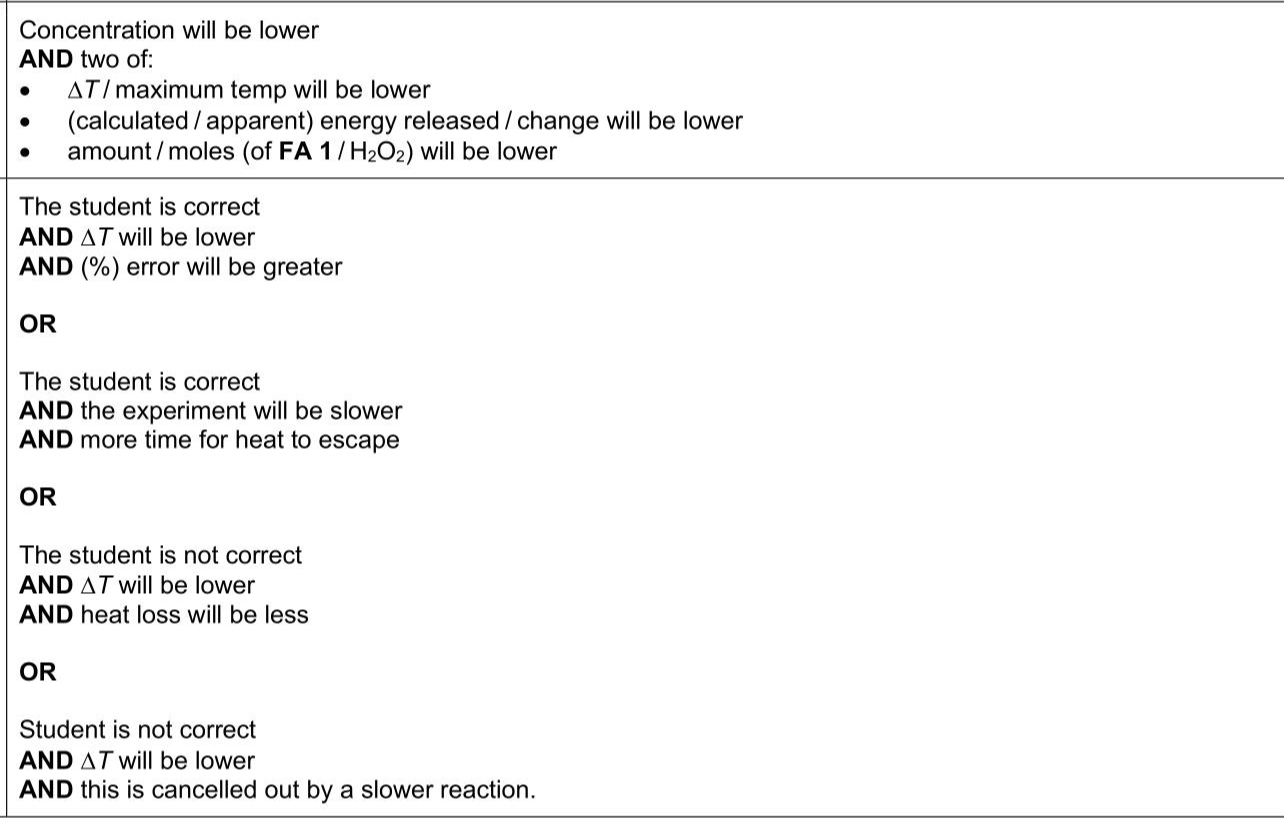You will now determine the concentration of a solution of hydrogen peroxide by a different method. Hydrogen peroxide decomposes slowly into water and oxygen at room temperature. This reaction is exothermic. When a catalyst is added, the decomposition is fast and there is a measurable temperature rise. $$\[ \mathrm{H}_{2} \mathrm{O}_{2}(\mathrm{aq}) \rightarrow \mathrm{H}_{2} \mathrm{O}(\mathrm{l})+\frac{1}{2} \mathrm{O}_{2}(\mathrm{~g}) \quad \Delta H=-98.2 \mathrm{~kJ} \mathrm{~mol}^{-1} \]$$ FA 1 is aqueous hydrogen peroxide, $$\(\mathrm{H}_{2} \mathrm{O}_{2}\)$$. FA 5 is manganese(IV) oxide, $$\(\mathrm{MnO}_{2}\)$$. The concentration of hydrogen peroxide in FA 1 calculated using the method given for Question 1 is more accurate than that using the method given for Question 2. (i) Heat loss is a large source of error when carrying out the method for Question 2. Describe and explain the effect of heat loss on the value of the concentration of hydrogen peroxide calculated. . . (ii) A student suggests that calculating the concentration of hydrogen peroxide using the method in Question 2 would be less accurate when the concentration is lower. Suggest whether the student is correct. Explain your answer. . You should record clearly at what stage in a test an observation is made. Where no change is observed,you should write'no change'. Where reagents are selected for use in a test,the name or correct formula of the element or compound must be given. If any solution is warmed,a boiling tube must be used.If a solid is heated,a hard-glass test-tube must be used. Rinse and reuse test-tubes and boiling tubes where possible. No additional tests should be attempted.
Exam No:9701_s25_qp_33 Year:2025 Question No:2(c)
Answer:

Knowledge points:
2.2.1 define and use the term mole in terms of the Avogadro constant
5.1.1 understand that chemical reactions are accompanied by enthalpy changes and these changes can be exothermic (ΔH is negative) or endothermic (ΔH is positive)
5.1.2 construct and interpret a reaction pathway diagram, in terms of the enthalpy change of the reaction and of the activation energy
5.1.3.1 standard conditions (this syllabus assumes that these are 298 K and 101 kPa) shown by
5.1.3.2 enthalpy change with particular reference to: reaction, , combustion, , neutralisation,
5.1.4 understand that energy transfers occur during chemical reactions because of the breaking and making of chemical bonds
5.1.5 use bond energies (ΔH positive, i.e. bond breaking) to calculate enthalpy change of reaction
5.1.6 understand that some bond energies are exact and some bond energies are averages
5.1.7 calculate enthalpy changes from appropriate experimental results, including the use of the relationships q = mcΔT and ΔH = –mcΔT/n
Solution:
Download APP for more features
1. Tons of answers.
2. Smarter Al tools enhance your learning journey.
IOS
Download
Download
Android
Download
Download
Google Play
Download
Download
